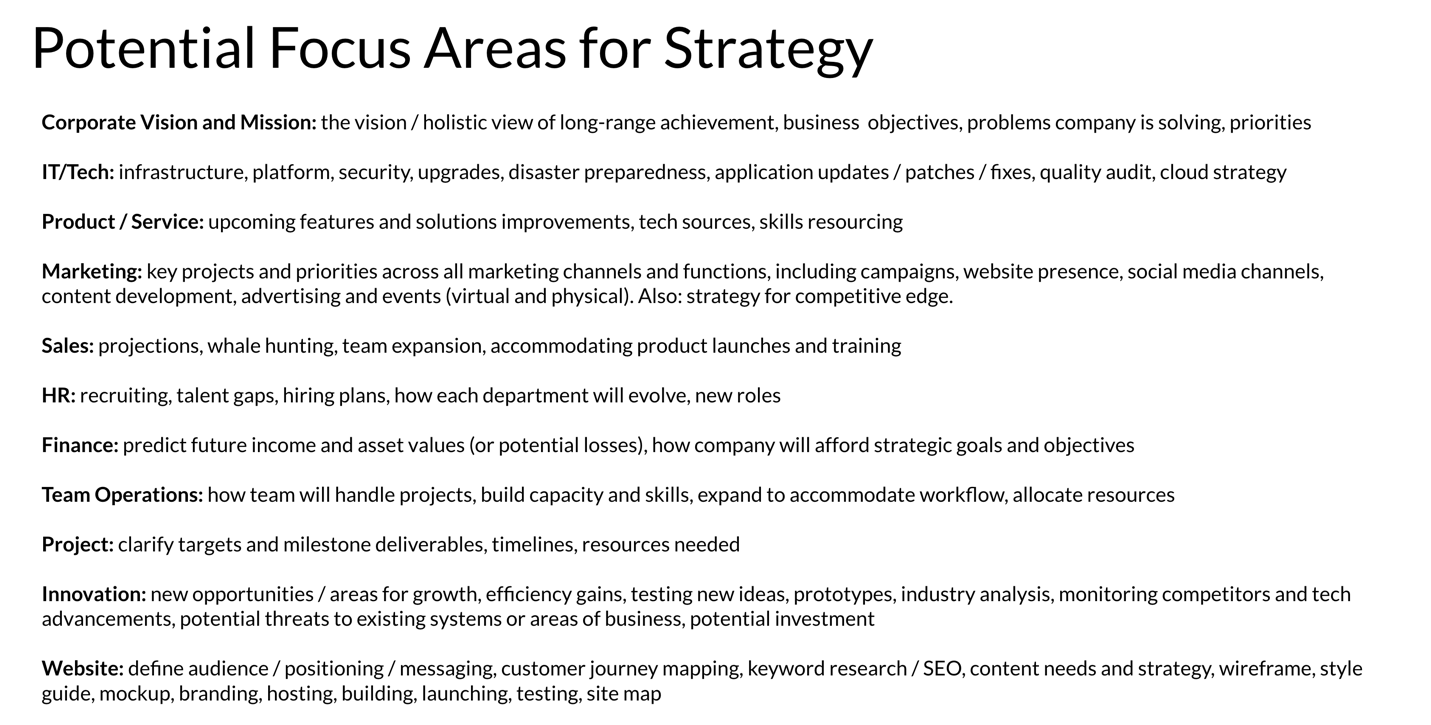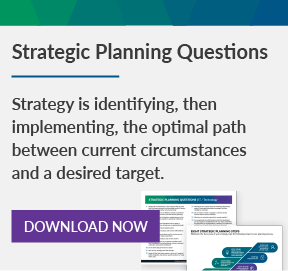Disruption shakes up the status quo, sometimes painfully, to catapult necessary growth. Strategy is the tool that can pivot disruption into new opportunities.
First, let’s define strategy. Strategy identifies and then becomes the optimal implementation path between current circumstances and a desired target strategy. Strategy reduces stress by gaining perspective and minimizing waste. Strategy helps allocate existing resources properly, determine what else is needed, and gives people a way to buy into action. So strategy is the optimal way to create a new outcome, meaning it optimizes effort, resources, and energy, while a strategic roadmap is the visual communication of that strategy.
Disruption is an amplifier that surfaces anything already happening in a business, whether it’s weak spots, strengths or potential opportunities. In other words, disruption amplifies what was already happening AND what is possible. Using strategy to focus the generative energy caused by disruption is constructive and can progress your business beyond where you are now. And that’s what we’re going to talk about – how to pivot disruption by applying strategy.
An irony of strategy is that, when done well, it looks effortless because the outcome is so obvious and natural. One of my personal favorite case studies around strategy is from Dell. Back in the day, all computer manufacturers had a ‘make to stock’ approach, which meant they would make computers in big quantities, store them in warehouses and then sell them as orders came through from customers. Essentially, they were using the economy of scale to build the same computer over and over and over again – that’s how they kept prices down.
Well, customers didn’t want stock computers – they wanted the computers they wanted. So Dell realized this and figured out an ‘assemble to order’ approach. Customers could choose their individual computer and have it assembled, a bit like ordering a Chipotle burrito these days. As the buying process progresses, the customer chooses their customizations from a common list of ingredients. For Dell, that meant that, within a week, customers could have the exact computer they wanted.
 Even more, Dell didn’t have to stock inventory, which made upgrades easy and cost-effective, eliminated losses due to obsolete parts or unhappy customers, and saved warehouse fees. As a result, IBM got pushed out of the computer market, while Compaq and HP merged in order to stay competitive. Dell became a top player in the personal computer market at that time. And it was all because of the strategy behind going from ‘make to stock’ to ‘assemble to order’. (Now we can’t imagine anything different, right?)
Even more, Dell didn’t have to stock inventory, which made upgrades easy and cost-effective, eliminated losses due to obsolete parts or unhappy customers, and saved warehouse fees. As a result, IBM got pushed out of the computer market, while Compaq and HP merged in order to stay competitive. Dell became a top player in the personal computer market at that time. And it was all because of the strategy behind going from ‘make to stock’ to ‘assemble to order’. (Now we can’t imagine anything different, right?)
Areas Where Business Needs Strategy
Back to your business now. There are different areas where you can use strategy to pivot disruption into opportunity – everything from your corporate vision and mission to IT and tech, product service, marketing, sales, HR, finance, operations, projects, innovation in offerings to what’s on your website. You can work through each functional area to audit what’s happening and what’s needed for improvement. Some of the questions you need to answer are:
- Is our company brand promise clear?
- Are we optimally positioned in our market?
- Are we sharing the right message?
- Do we have the right processes in place?
- Do we have the right people and the right skill sets available for high performance?

Remember, strategy gives perspective for the optimal path to getting the outcome you want with the least stress. Sometimes the goal will change as new information presents. Sometimes strategy reveals an even better outcome is possible. Sometimes the gift of strategy is simply attention to highlight issues and limitations so they can be addressed. And sometimes strategy is about innovating a completely new solution.
Once you have identified a big ‘what’ and ‘why’ strategy, you want to be able to communicate that strategy. When it comes to strategy, typically a visual roadmap is used. Visual roadmaps consolidate information in such a way as to make a strategy easily apparent. A strategic roadmap considers the alignment with and between business targets, potential resources needed to implement that strategy, milestones, timeframes, dependencies between individuals and teams to implement. The roadmap is a powerful way to show the why and the what of actions across the organization.
There is a second type of roadmap, which is the ‘how’ of implementing strategy; that is typically addressed by tactical or team-based roadmaps. This kind of planning works in synergy. Once you know the why and the bigger vision, you can then put in place how you’re going to get there.

There are two different ways to show a roadmap – by timeline or by lane view. In the timeline view, you show what you’re going to do in Q1, Q2, Q3, Q4, etc. (or this month, next month, the following month, or sprint 1, sprint 2, sprint 3, etc.). You can also do what’s called a lane view, which shows columns of action items. For example, the first column might show the backlog, the second column the items in process, and a third column for what’s been completed. Both ways work so it’s about what makes sense for your project, your team, your strategy, your organization.
Of course, XTIVIA is a tech implementation and integrations company, so we think about how to help companies strengthen their IT environment. When you’re going to look at what your tech is doing strategically, we have a list of questions that can help jumpstart that process. (You can get a download of that list here.)
The 8 Steps of Strategy
In terms of putting together a strategy, there are eight steps to that process, regardless of the area of focus in your company, to be predictably effective.
- Define where you are/current circumstances.
First, you need to define the current situation. If you don’t know where you are, it’s hard to plan how to leave it behind (because, without definition, you will perpetually be where you are now). - Articulate the vision / desired outcome and/or targets.
Where are you trying to go? What are you trying to achieve? Identify and then clearly articulate the vision, desired outcome and/or business targets so others can understand and buy-in to the result. - Prioritize objectives; decide specific deliverables (to ‘chunk down’ success and assign timeframes).
Just like the old adage says, the only way to eat an elephant (or reach a vision/outcome) is one bite (step) at a time. Break the next steps for the ultimate goal into sections, then into tasks, and assign probably timeframes. When you don’t set timeframes, there is no urgency to get them done so remember to make deadlines a priority. - Identify resources (skills, people, financial investment) needed to achieve deliverables.
Your plan will require resources to achieve it. Think of it like nurturing a plant; a plant will need water, sun, fertilizer, pruning, etc. What does your plan require in terms of people, process, skills, financial resources? Make sure your strategy includes how to get or reallocate those already existing resources toward achieving your goal. - Determine who is accountable for achieving results.
When you leave it to chance for ‘someone’ to do something, it’s probable it won’t get done. Why? Because of the Abilene Paradox, where members of a group each assume others want something different so they don’t voice their preference. Said another way, if a group of people own a car, who is responsible for getting the oil changed? Make sure there is a point person for each task in your strategic plan. - Implement the plan.
A plan without action remains a vision. Action without strategy creates diffused chaos. Implement what you’ve laid out in sequential order. - Monitor progress and update the plan.
As implementation occurs, monitor the progress. Plans evolve as you take action so be sure to update the plan as you go. Tip: it’s helpful for someone to act as project manager of the plan to note each task as it changes or is completed so the plan is always current. - Refine the plan as new information presents.
One of the hallmarks of action is learning through experience. As you work the plan, your team will learn better ways to implement it going forward. You may get unexpected results which can also impact the plan. Know the plan is a living, evolving document that will become a current representation of where your company is and where it’s going with purpose.
So that’s an outline of the steps that it takes to put together a good strategy.
In summary, disruption provides generative energy. It’s not the end of the world; instead, disruption is energy you can use to generate results for future success. Strategy optimizes your focus and resources to achieve your identified business targets. Virtually every part of any company needs a strategic plan; roadmapping a strategy means visually communicating that plan. Keep the eight steps of strategic planning handy as a guide in terms of getting everybody focused on the same systematic growth process. And be sure to download your list of questions that can help jumpstart the process of strategically upgrading, or streamlining, your IT environment.
My observation is that disruption is an amplifier of what’s already happening in your business. Use the energy caused by the disruption to pivot more purposefully and thrive post-crisis. And if you want to explore your strategies in a personal conversation, please reach out (with no obligation) so we can have a chat. I look forward to it.
To access our entire B2B Pivot Series, it is available for download here.


